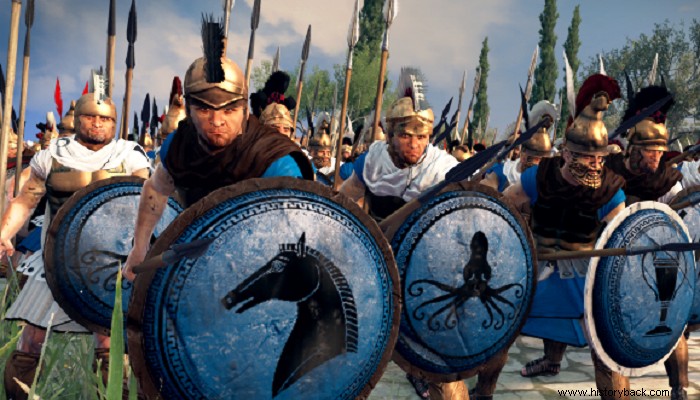
In 311 BC Carthage and Syracuse were at war once more. The Syracusans under Agathocles had suffered a heavy defeat losing 7,000 men. The defeated Agathocles retreated to Gela attracting the attention of numerous opponents to delay and allow the citizens of Syracuse to harvest before the arrival of the Carthaginians before the walls.
The Carthaginian general Amilkas tried to capture Gela but failed and turned towards Syracuse. Agathoklis then decided to perform a very risky maneuver crossing with his army into North Africa, leaving responsibility for the defense of his city to his brother Andandros.
It is not known how many men Andandros had, but he certainly fell short against Amilcas' at least 125,000 infantry and cavalry . Agathocles killed his rich political opponents and confiscated their properties thus obtaining the necessary money for the war. Then he set sail for Africa.
First attack and siege
In Africa he managed to defeat the Carthaginian Army at the Tunis River . The leaders of Carthage then asked Amilcas to send reinforcements. But he preferred to attempt to deceive the Syracusans by spreading the rumor that Agathocles and his army had been destroyed. Andandros didn't give in, although some citizens cooled down a bit. Amilkas then decided to take advantage of the panic, as he believed, of the Syracusans and attack.
In the meantime, two ships sent by Agathocles to announce his victory arrived at the port. The Syracusans, including most of the guards of the walls, hastened to the harbor to hear the news. Amilkas was quick to take advantage of the situation. So he sent a very strong body of his men equipped with siege scales to capture the walls.
The Carthaginians began to climb the walls without being noticed. However, when they went up a patrol saw them and gave the alarm. Immediately the soldiers and every other man available rushed to the walls. The Greeks rushed at the Carthaginians and managed, fighting heroically, to overthrow them. Humiliated, Amilkas ordered a retreat. At the same time, he sent 50,000 of his men to Carthage, no longer able to ignore the orders he had received.
After this, Amilkas was confined to the close siege of the city, which, however, was well fortified and supplied. Thus the siege dragged on. The year 309 BC had already come The Carthaginian general managed to conquer the region of Olympia, south of the city, near Mega Limenas and decided to try a new raid against the city.
Impossible counterattack
The Carthaginians began to move in the night. But the Syracusans perceived the movements of their opponents. The first to see the Carthaginians marching incoherently towards the walls the guards of the fort of Evryalos and decided to make an exit by surprising the enemies.
In the darkness led by Amilkas and the Syracusian Deinocrates the Carthaginians marched carelessly with the infantry moving divided into two bodies. The combatants were followed by a multitude of followers and various other suspicious elements who aimed to plunder the city.
But they quarreled with some soldiers and a regular battle broke out. The result was to cause further disorder in the Carthaginian lines than the narrow and rough road had caused.
Just then 3,400 Greeks (3,000 infantry, 400 cavalry) fell upon the Carthaginians in the middle of the night like creatures of Hades. The latter, unable to realize how many of their opponents there were, panicked and disgracefully put it to their feet. Most were killed simply by being trampled under foot by their colleagues. Many fewer fell from the Greek weapons. Amilkas who tried to restrain his men was captured.
The next day alone the extent of the destruction was seen. The Carthaginian Army was scattered. Amilka's fate was not pleasant. After first being humiliated by marching in irons through the streets of Syracuse hearing the curses and being abused by the crowd, he was executed. However, the war continued until 306 BC. with the rivals agreeing to a peace treaty that left eastern Sicily to Agathocles.
